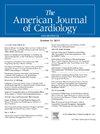曾接受过冠状动脉旁路移植术的患者接受经皮冠状动脉介入治疗后的疗效。
IF 2.3
3区 医学
Q2 CARDIAC & CARDIOVASCULAR SYSTEMS
引用次数: 0
摘要
对于既往接受过 CABG 并需要进行后续 PCI 的患者,尚不确定应该选择旁路移植还是原生冠状动脉。我们分析了墨尔本介入组登记(2005-2018 年)中 2,764 名既往接受过 CABG 的患者的数据,将其分为两组:对原生血管进行 PCI 的患者(n=1,928)和对移植血管进行 PCI 的患者(n=836)。本文章由计算机程序翻译,如有差异,请以英文原文为准。
Outcomes After Percutaneous Coronary Intervention in Patients With Previous Coronary Artery Bypass Grafting
In patients with previous coronary artery bypass graft surgery (CABG) requiring subsequent percutaneous coronary intervention (PCI), there is uncertainty whether bypass grafts or native coronary arteries should be targeted. We analyzed data from 2,764 patients with previous CABG in the Melbourne Interventional Group registry (2005 to 2018), divided into 2 groups: those who underwent PCI in a native vessel (n = 1,928) and those with PCI in a graft vessel (n = 836). Patients with a graft vessel PCI were older, had more high-risk clinical characteristics (previous myocardial infarction, heart failure, ejection fraction <50%, renal impairment, peripheral and cerebrovascular disease), and had high-risk procedural features (American College of Cardiology and American Heart Association types B2/C lesions). However, patients in the native vessel group were more likely to have PCI in chronic total occlusions. The majority of graft PCI were in saphenous vein grafts (84%), with 10% to radial and 6% in left/right internal mammary artery grafts. Distal embolic protection devices were used in 30% of graft PCI. Patients with graft PCI had higher rates of no reflow (6.3 vs 1.5%, p <0.001), coronary perforation (p = 0.02), and inpatient stent thrombosis (p = 0.03). However, the 30-day mortality and major adverse cardiovascular and cerebrovascular events were similar. The unadjusted long-term mortality (median follow-up of 4.8 years) was higher in patients who underwent a graft PCI (44 vs 32%, p <0.001); however, after Cox proportional hazards modeling, PCI vessel type was not a predictor of long-term mortality (hazard ratio 1.13, 95% confidence interval 0.96 to 1.33, p = 0.14). In conclusion, early clinical outcomes and risk-adjusted long-term mortality are similar for patients with previous CABG who underwent PCI in a native vessel or a bypass graft.
求助全文
通过发布文献求助,成功后即可免费获取论文全文。
去求助
来源期刊

American Journal of Cardiology
医学-心血管系统
CiteScore
4.00
自引率
3.60%
发文量
698
审稿时长
33 days
期刊介绍:
Published 24 times a year, The American Journal of Cardiology® is an independent journal designed for cardiovascular disease specialists and internists with a subspecialty in cardiology throughout the world. AJC is an independent, scientific, peer-reviewed journal of original articles that focus on the practical, clinical approach to the diagnosis and treatment of cardiovascular disease. AJC has one of the fastest acceptance to publication times in Cardiology. Features report on systemic hypertension, methodology, drugs, pacing, arrhythmia, preventive cardiology, congestive heart failure, valvular heart disease, congenital heart disease, and cardiomyopathy. Also included are editorials, readers'' comments, and symposia.
 求助内容:
求助内容: 应助结果提醒方式:
应助结果提醒方式:


